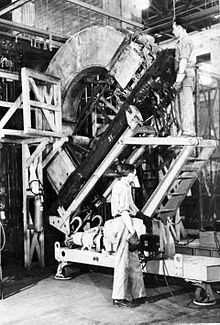
Back كاليوترون Arabic Calutron German Calutrón Spanish کالوترون FA Calutron French קלוטרון HE カルトロン Japanese 캘루트론 Korean Calutron NN Calutron NB

A calutron is a mass spectrometer originally designed and used for separating the isotopes of uranium. It was developed by Ernest Lawrence during the Manhattan Project and was based on his earlier invention, the cyclotron. Its name was derived from California University Cyclotron, in tribute to Lawrence's institution, the University of California, where it was invented. Calutrons were used in the industrial-scale Y-12 uranium enrichment plant at the Clinton Engineer Works in Oak Ridge, Tennessee. The enriched uranium produced was used in the Little Boy atomic bomb that was detonated over Hiroshima on 6 August 1945.
The calutron is a type of sector mass spectrometer, an instrument in which a sample is ionized and then accelerated by electric fields and deflected by magnetic fields. The ions ultimately collide with a plate and produce a measurable electric current. Since the ions of the different isotopes have the same electric charge but different masses, the heavier isotopes are deflected less by the magnetic field, causing the beam of particles to separate into several beams by mass, striking the plate at different locations. The mass of the ions can be calculated according to the strength of the field and the charge of the ions. During World War II, calutrons were developed to use this principle to obtain substantial quantities of high-purity uranium-235, by taking advantage of the small mass difference between uranium isotopes.
Electromagnetic separation for uranium enrichment was abandoned in the post-war period in favor of the more complicated, but more efficient, gaseous diffusion method. Although most of the calutrons of the Manhattan Project were dismantled at the end of the war, some remained in use to produce isotopically enriched samples of naturally occurring elements for military, scientific and medical purposes.